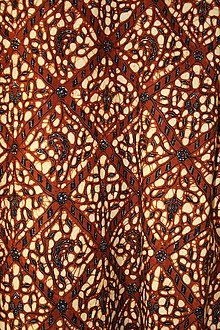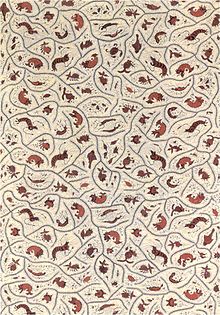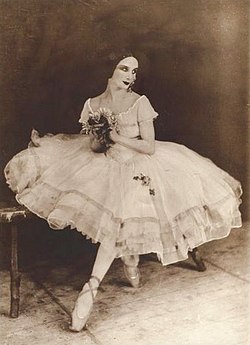High-heeled footwear
From Wikipedia, the free encyclopedia
High-heeled footwear (often abbreviated as high heels or simply heels) is footwear that raises the heel of the wearer's foot significantly higher than the toes and often can be worn without socks. When both the heel and the toes are raised equal amounts, as in a platform shoe, it is technically not considered to be a "high-heel"; however, there are also high-heeled platform shoes. High heels tend to give the aesthetic illusion of longer, more slender and more toned legs. High-heels come in a wide variety of styles, and the heels are found in many different shapes, including stiletto, pump (court shoe), block, tapered, blade, and wedge.
According to high fashion shoe websites like Jimmy Choo and Gucci, a "low heel" is considered less than 2.5 inches (6 centimeters), while heels between 2.5 and 3.5 inches (8.5 cm) are considered "mid heels," and anything over that is considered a "high heel"[citation needed].
Although high heels are now almost exclusively worn by girls and women, there are shoe designs worn by both genders that have elevated heels, including cowboy boots and cuban heels. In previous ages men also wore high heels.
History
The high-heeled shoe, or a shoe whose heel is higher than the toe, is a matter of contentious and heated discussion. Shoes in general have typically served as markers of gender, class, race, and ethnicity—and both the foot and the shoe have been imbued with powerful phallic and fertility symbols as evidenced in the contemporary practice of tying shoes to a newlywed couple’s car. No other shoe, however, has gestured toward leisure, sexuality, and sophistication as much as the high-heeled shoe. Fraught with contradiction, heels paradoxically inhibit movement in order to increase it, at least in appearance. Standing in heels, a woman presents herself already half-walking while at the same time reducing the length of her step, fostering the illusion of speed while suggesting an imminent fall. The higher and more unstable the heel, the more clearly these contradictions are expressed (Kunzle 2004)[where?]. Doctors and scholars alike have argued about the physical and cultural effect, both positive and negative, that heels have had not only on women, but on society as a whole..
Precursors to the high-heeled shoe
Most of the lower class in ancient Egypt walked barefoot, but figures on murals dating from 3500 B.C. depict an early version of shoes worn mostly by the higher classes. These were leather pieces held together with lacing that was often arranged to look like the ankh symbol, which represents life. But there are also some depictions of both upper-class males and females wearing heels, probably for ceremonial purposes. Egyptian butchers also wore heels, to help them walk above the blood of dead beasts. In ancient Greece and Rome, platform sandals called kothorni, later known as buskins in the Renaissance, were shoes with high wood or cork soles that were popular particularly among actors who would wear shoes of different heights to indicated varying social status or importance of characters. In ancient Rome, sex trade was legal and female prostitutes were readily identified by their high heels (Encyclopedia of ancient Greece By Nigel Guy Wilson 2005).
During the Middle Ages, both men and women would wear pattens, or wooden soles, that were clearly a precursor to the high heel. Pattens would attach to fragile and expensive shoes to keep them out of the mud and other street debris when walking outdoors (Swann 1984).
Elizabeth Semmehack, curator at the Bata Shoe Museum, traces the high heel to horse-riders in the Near East who used high heels for functionality, because they help hold the rider's foot in stirrups. She states that this footwear is depicted on a 9th-century ceramic bowl from Persia.[1]
In the 15th century, chopines, a type of platform shoes, were created in Turkey and were popular throughout Europe until the mid-17th century. Chopines could be seven to eight or even 30 inches high, requiring women to use canes or servants to help them walk. Like pattens, chopines were overshoes, but unlike the pattens, chopines were worn almost exclusively by women (Rexford 2000)[where?]. They were usually designed with cork or wood stacked as the heel.
The Venetians made the chopine into a status symbol revealing wealth and social standing for women, and tourists to Venice often remarked humorously on the outrageously high chopines. One visitor noted that they were “invented by husbands who hoped the cumbersome movement [that] entailed would make illicit liaisons difficult” (McDowell 1989)[where?]. Already we can see issues of domination and submission being associated with shoes much like the lotus shoes of China. Indeed, Chinese concubines and Turkish odalisques wore high shoes, prompting scholars to speculate if heels were used not only for aesthetic reasons but also to prevent women from escaping the harem (Kunzle 2004)[where?].
Shoes were beginning to be made in two pieces during the 16th century, with a flexible upper attached to a heavier, stiffer sole (Swann 1984)[where?]. This new two-part shoe led to the heel as an actual part of the shoe rather than just an attachable overshoe.
It is sometimes suggested that raised heels were a response to the problem of the rider's foot slipping forward in stirrups while riding.[1] The "rider's heel," approximately 1-1/2 inch (4 cm) high, appeared around 1500. The leading edge was canted forward to help grip the stirrup, and the trailing edge was canted forward to prevent the elongated heel from catching on underbrush or rock while backing up, such as in on-foot combat. These features are evident today in riding boots, notably cowboy boots.
The simple riding heel gave way to a more stylized heel over its first three decades. Beginning with the French, heel heights among men crept up, often becoming higher and thinner, until they were no longer useful while riding, but were relegated to "court-pony" wear. By the late 17th century, men's heels were commonly between three and four inches in height.
In 1533, after men had already started wearing heels again. The diminutive Italian wife of Henry II, King of France, Queen Catherine de' Medici, commissioned a cobbler to fashion her a pair of heels, both for fashion, and to suggest greater height. They were an adaptation of chopines and pattens (elevated wooden soles with both heel and toe raised, not unlike modern platform shoes or clogs and sabots), intended to protect the feet of the wearer from dirt and mud; but unlike chopines, the heel was higher than the toe and the "platform" was made to bend in the middle with the foot. That raised shoes had already been worn as a fashion statement in Italy, at least, is suggested by sumptuary laws in Venice that banned the wearing of chopine-style platform shoes as early as the 1430s.
High-heeled shoes quickly caught on with the fashion-conscious men and women of the French court, and spread to pockets of nobility in other countries. The term "well-heeled" became synonymous with opulent wealth.[2][unreliable source?] Both men and women continued wearing heels as a matter of noble fashion throughout the seventeenth and eighteenth centuries. When the French Revolution drew near, in the late 18th century, the practice of wearing heels fell into decline in France due to its associations with wealth and aristocracy. Throughout most of the 19th century, flat shoes and sandals were usual for both sexes, but the heel resurfaced in fashion during the late 19th century, almost exclusively among women.
High-heels today
Throughout the last 60 years high-heels have fallen in and out of favor several times, most notably in the late 1990s, when lower heels and even flats predominated[citation needed]. Lower heels were preferred during the late 1960s and early 1970s as well, but higher heels returned in the late 1980s and early 1990s. The shape of the fashionable heel has also changed from block (1970s) to tapered (1990s), and stiletto (1950s, 1980s, and post-2000).
Today, high-heels are typically worn by women, with heights varying from a kitten heel of 1½ inch (4 cm) to a stiletto heel (or spike heel) of 4 inch (10 cm) or more. Extremely high-heeled shoes, such as those higher than 5 inch (13 cm), are normally worn only for aesthetic reasons and are not considered practical. Court shoes are conservative styles and often used for work and formal occasions, while more adventurous styles are common for evening wear and dancing. High-heels have seen significant controversy in the medical field lately, with many podiatrists seeing patients whose severe foot problems have been caused almost exclusively by high-heel wear.
Wedge heel is informally another style of the heel, where heel is in a wedge form and continues all the way to the toe of the shoe.[3]
Reasons against wearing high-heels, which are almost exclusively health and practicality reasons, include:
- they can cause foot pain
- they increase likelihood of sprains and fractures
- they make calves look more rigid and sinewy
- they can create foot deformities, including hammertoes and bunions
- they can cause an unsteady gait
- they can shorten the wearer's stride
- they can render the wearer unable to run
- altered forces at the knee caused by walking in high-heels may predispose to degenerative changes in the knee joint
- See "Foot and Tendon Problems" below for many of the medical reasons.
- Women who wear high heels frequently have a higher incidence of degenerative joint disease of the knees. This is because they cause a decrease in the normal rotation of the foot which puts more rotation stress on the knee
Reasons for wearing high-heels, which are almost exclusively aesthetic, include:
- they change the angle of the foot with respect to the lower leg, which accentuates the appearance of calves
- they change the wearer's posture, requiring a more upright carriage and altering the gait in what is considered a seductive fashion
- they make the wearer appear taller
- they make the legs appear longer
- they make the foot appear smaller
- they make the toes appear shorter
- they make the arches of the feet higher and better defined
- they make the lower leg muscles more defined
- they make the gluteus maximus more defined
- they may improve the tone of a woman's pelvic floor.[4][5]
Types of high heels
Types of heels found on high-heeled footwear include:[6]
- cone: a round heel which is broad where it meets the sole of the shoe and noticeably narrower at the point of contact with the ground
- kitten: a short, slim heel with maximum height under 2 inches and diameter of no more than 0.4 inch at the point of contact with the ground
- prism: three flat sides which form a triangle at the point of contact with the ground
- spool: broad where it meets the sole and at the point of contact with the ground; noticeably narrower at the midpoint between the two
- stiletto: a tall, slim heel with minimum height of 2 inches and diameter of no more than 0.4 inch at the point of contact with the ground
- wedge: occupies the entire space under the arch and heel portions of the foot
- puppy: thick square block heel approx. 2 inches in diameter and height.
- teletop: sharp square toe, generally worn by the higher in society
- tinkatop: round ball like toe - generally found in 'puppies' or 'kittens'
Men and heels
Although high heels originated in France as male footwear around 1500, since the late 18th century, men's shoes have had primarily low heels. A notable exception is cowboy boots, which continue to sport a taller riding heel. The two-inch Cuban heel features in many styles of men's boot, but was popularised by Beatle boots, famously worn by the English rock group, The Beatles, which saw the reintroduction of heels for men which some men still wear high heels today .[7] Winklepicker boots also usually feature a Cuban heel. There was also a brief resurgence in higher-heeled shoes for men in the 1970s[8](in Saturday Night Fever, John Travolta's character wears a Cuban heel in the opening sequence). The singer Prince is known to wear high heels, as well as Elton John. Bands such as Mötley Crüe and Sigue Sigue Sputnik predominantely wore high heels during the 1980s. Currently being worn by Bill Kaulitz, the lead singer of Tokio Hotel, are wedges.
Accessories
The stiletto of certain kinds of high-heels can damage some types of floors. Such damage can be prevented by heel protectors, also called covers, guards, or taps, which fit over the "stiletto" tips to keep them from direct, marring contact with delicate surfaces, such as linoleum (rotogravure) or urethane-varnished wooden floors. Heel protectors are widely used in ballroom dancing, as such dances are often held on wooden flooring. The bottom of most heels usually has a plastic or metal heel tip that wears away with use and can be easily replaced. Dress heels (high-heeled shoes with elaborate decoration) are worn for formal occasions. Many philanthropies have been created around the central idea of men fighting gender violence by wearing high heel shoes and "walking a mile in her shoes". This theme has shown up in display windows in malls and across several cities in the United States.
Foot and tendon problems
High-heeled shoes slant the foot forward and down while bending the toes up. The more that the feet are forced into this position, the more it may cause the Achilles tendon to shorten.[9] This may cause problems when the wearer chooses lower heels or flat-soled shoes. When the foot slants forward, a much greater weight is transferred to the ball of the foot and the toes, increasing the likelihood of damage to the underlying soft tissue which supports the foot. In many shoes, style dictates function, either compressing the toes, or forcing them together, possibly resulting in blisters, corns, hammer toes, bunions (hallux valgus), Morton's neuroma and many other medical conditions, most of which are permanent, and will require surgery to alleviate the pain. High heels—because they tip the foot forward—put pressure on the lower back through making the rump push outwards and crushing the lower back vertebrae and contracting the muscles of the lower back.[10]
If it is not possible to avoid high heels altogether, it is suggested that the wearer spend at least a third of the time on their feet in contour-supporting "flat" shoes (such as exercise sandals), or well-cushioned "sneaker-type" shoes, saving high heels for special occasions.
One of the most critical problems of high-heeled-shoe design involves a properly constructed toe-box. Improper construction here can cause the most damage to one's foot. Toe-boxes which are too narrow force the toes to be "crammed" too close together. Ensuring that room exists for the toes to assume a normal separation so that high-heel wear remains an option rather than a debilitating practice, is an important issue in improving the wearability of women's high-heeled fashion shoes.
Wide heels do not necessarily offer more stability, and any raised heel with too much width, such as found in "blade-" or "block-heeled" shoes, induces unhealthy side-to-side torque to the ankles with every step, stressing them unnecessarily, while creating additional impact on the balls of the feet. Thus, the best design for a high-heel is one with a narrower width, where the heel is closer to the front, more solidly under the ankle, where the toe box provides room enough for the toes, and where forward movement of the foot in the shoe is kept in check by material snug across the instep, rather than by the toes being rammed forwards and jamming together in the toe box, or crushed into the front of the toe box.
Despite the medical issues surrounding high-heel wear, a few podiatrists recommend well-constructed low to moderate heels for some patients[citation needed]. It appears a slight elevation of the heel improves the angle of contact between the metatarsals and the horizontal plane, thereby more closely approximating the proper angle and resulting in proper weight distribution of a medium-to-high-arched foot. Other foot specialists, however, argue that any heel causes unnecessary stresses on the various bones and joints of the foot.
Potential health benefits
A recent study suggested that wearing high heels may improve the tone of a woman's pelvic floor.[4][5]
Feminist attitudes towards high heels
The high heel has been a central battleground of sexual politics ever since the emergence of the
women’s liberation movement of the 1970s. Many second-wave feminists rejected what they regarded as constricting standards of female beauty, created for the subordination and objectifying of women and self-perpetuated by reproductive competition and women's own aesthetics.
[11] Some
feminists[who?] argue that the high heels were designed to make woman helpless and vulnerable, perpetuating the
gender role of males as protectors of the slowly staggering women. High heels have also been blamed for reducing the woman into a
sex object, by sacrificing practical comfort in favor of an alleged increase in
sex appeal. Some second wave feminists such as
Judy Grahn have tied high heels to menstruation rituals that various cultures have used.


















